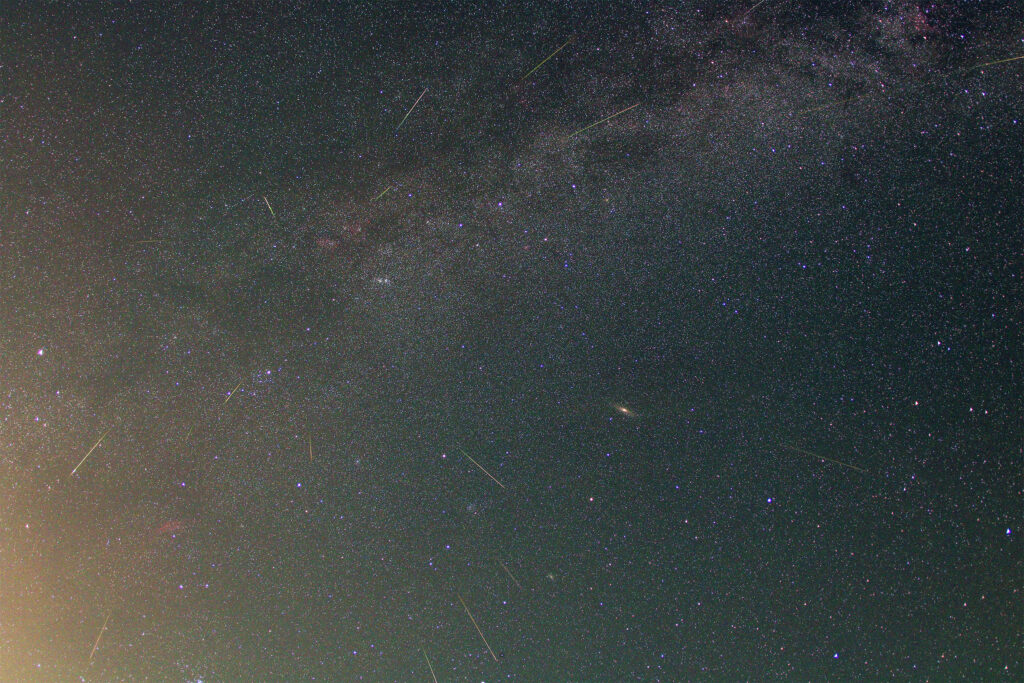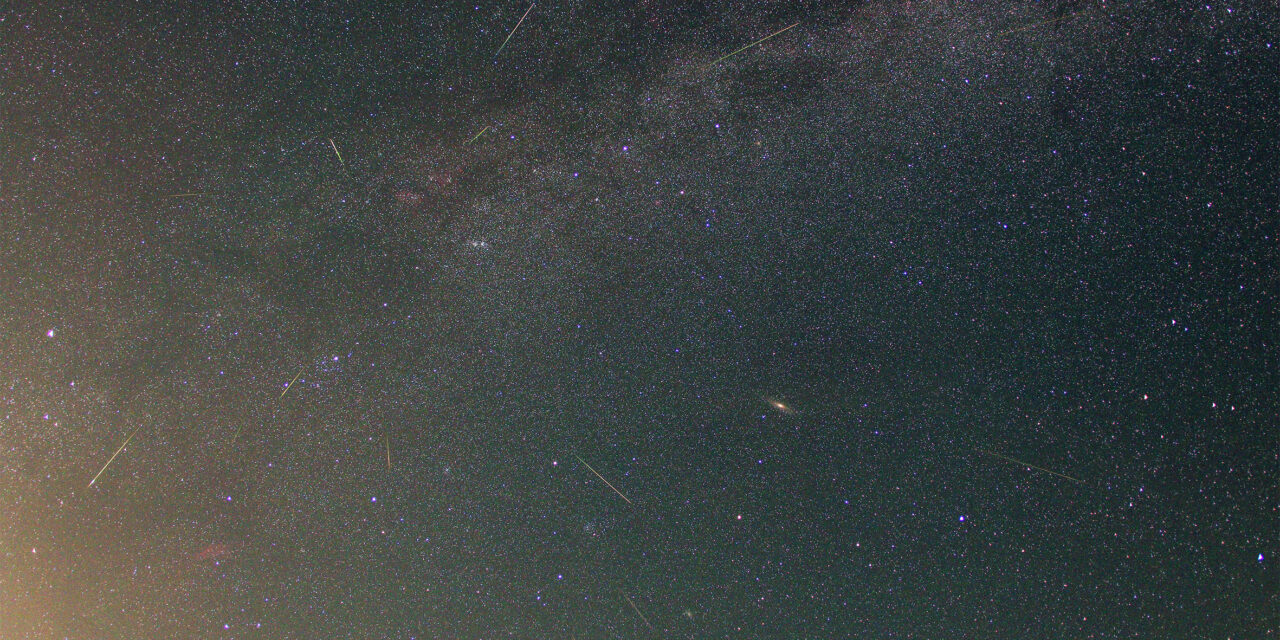Carl Johannink & Koen Miskotte
Abstract
Report on a short Perseid campaign at the COSMOS Public Observatory near Lattrop (Dutch/German border). Three more or less clear nights is a good result to Dutch standards.
Introduction
The summer of 2021 treated the Netherlands on very unstable weather. This meant low temperatures, but also a lot of clouds and rain. At the beginning of August, the authors decided to try to observe the Perseid maximum from the COSMOS Public Observatory near Lattrop between August 10 and 13. As this period approached, it seemed that we certainly would experience some clear skies around the Perseid maximum.
Pre-maximum observations
In the period before the maximum, Koen was able to observe for a number of nights. The first was July 17–18. 2.00 hours effectively yielded 19 meteors. Besides the sporadic (SPO) meteors, 3 Perseids (PER), 1 Capricornid (CAP) and 1 Antihelion (ANT) were seen. The most beautiful meteor was a very slow –1 SPO moving through Aquila. Afterwards, according to CAMS BeNeLux observations, this turned out to have been a kappa Cygnid (KCG). This night’s observations were done from a new spot on the Groevenbeekse Heide near Ermelo. The old site was gradually surrounded by bushes that obstructed the view and this place was also prone to ground fog. The new site is more than 1.5 meters higher and 50 meters to the east. It is located on top of a so-called ice age wall. Debris has accumulated due to ice retention and because of that the landscape is slightly sloping. There was indeed ground fog this night, but it remained below the field of view.
During the evening of July 31, Koen was able to observe at home from the dormer for half an hour before the clouds struck again. Koen counted 6 meteors of which 2 PER and 1 southern delta Aquariid (SDA). The latter was of a fine caliber, this –1 SDA slowly moved up from the horizon near the square of Pegasus. Further observations could be made in the evening of 8 August. During 0.95 hours, 19 meteors were counted. The Perseids were gaining strength, with 6 PER, 1 SDA and 2 KCG being seen despite the low radiant setting. The most beautiful meteor was a nice magnitude 0 KCG in Andromeda. All other nights were cloudy.
Observations at the Cosmos Observatory near Lattrop
August 10–11
In the afternoon of August 10, Koen traveled by train to Enschede where he teamed up with Carl. The train was of course delayed again, but Carl was prepared for that in view of previous experiences with people to be picked up at the station in Enschede: he went to have a cappuccino with something delicious in the city center of Enschede and after this short break he went back to the station. That was easier said than done. The city center of Enschede can be reached faster on foot than by car. But in the end, he managed to reach the station via a detour. Koen was already waiting at the exit. It was good to see each other “live” again. After a nice meal there was a little nap before hunting the meteors. Once Carl had started the CAMS systems at home we left for the observatory. We arrived there around half past ten and we met for the first time in a long (due to the covid pandemic) Peter van Leuteren, Sietse Dijkstra and his son Simon. There was not much time to chat, the sky was clear! Not very bright, but with a limiting magnitude of 6.4 we couldn’t complain. We were all looking for a spot at the observatory’s parking lot.
The observations took place between 21:08 and 01:30 UT. The Perseids were performing below their usual strength, at least that was the impression. The hourly counts were rather flat and up to a maximum of 21 Perseids an hour. The kappa Cygnids however were clearly active! No fireballs were seen this night, but a couple of KCG of 0 and +1. In addition, the hourly counts were also very nice, up to a maximum of 6 kappa Cygnids per hour. The night was calm, there was some fog hanging over the adjacent meadow. Around 2:00 UT, Koen and Carl drove back to Gronau, a 30-minute drive.
August 11–12
During the day there was again the ritual of a late breakfast with tasty brötchen and a walk through Gronau. From a local terrace we pleasantly saw a beautiful blue sky. After dinner, the observers had another nap in the evening. This way the observations were easy to maintain! This time we drove a different route to the observatory on the Dutch side. The Twente landscape is also beautiful and dark at night. Also present at the observatory were Peter, Sietse, Simon and various employees of the COSMOS observatory, including Arnold Tukkers. Tonight is a regular public viewing evening at the observatory. So, it was busy the first hour. The parking lot was already fairly full with cars, luckily not yet where we would observe. One option was to observe a kilometer to the north, but we had serious concerns about fog. There were already some patches of fog in the adjacent meadow. We decided to observe at the observatory. Carl parked his car in such a way that we were as little disturbed as possible by the other cars when they drove away. Indeed, until 22:10 UT we were occasionally disturbed by departing guests. In addition, we also clearly heard how Arnold Tukkers enthusiastically explained the Perseids to the guests from the roof terrace. Around 22:20 UT we saw the light beams of a car turning into the parking lot. Just around that time Koen sees a nice –5 kappa Cygnid in Pegasus, the other observers saw two flashes of light: one from the meteor and one from the car parked at that moment. For a moment we thought it is still an employee of the observatory, but a little bit later it became clear that they were three students from Almelo, who wanted to view the Perseids. They just lay down on the floor to enjoy the spectacle. Again, we had the impression that the Perseids hadn’t really picked in activity yet. The hourly counts were between 20 and 28. Things got better in the last hour, but unfortunately the sky got obscured from the west around 00:15 UT with thick cirrus. Before that, we had a bit more trouble with mist or fog, so that the limiting magnitude was slightly lower than the previous night. The three students got cold, and the uncomfortable surface is no reason to stay any longer. They left for Almelo again.
The KCGs were again clearly present with hourly frequencies between 4 and 6. In addition to the –5 KCG, a number of 0 and +1 were also seen. The Perseids delivered another set of –2 and –1 meteors. We waited for better skies for a while after 00:15 UT, but eventually left for Gronau around 1 UT. This time we drove back via Germany. Suddenly Carl turned into a small road but then immediately had to hit the breaks heavily! A deer suddenly darted out of the bushes a few meters in front of the car over the road. When asked by Koen why we turned there, Carl told him that we had observed the Taurids of 2005 and the Perseids of 2007 at this location. Koen indeed recognized the location afterwards.

Figure 1. Perseid meteors captured at the Cosmos Observatory on the night of August 12-13, 2021 | Canon 750D Mod, 15mm F/2.8 Fish-eye lens, exposure time subs 30 seconds, followed with an IOptron CEM60 mount. Courtesy of Peter van Leuteren.


